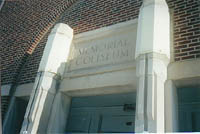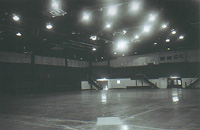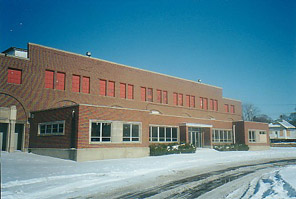Memorial Coliseum
Since 1928, Memorial Coliseum has played an integral role in the history and development of Marion. In the words of Bill Munn, "It has been at the center of community life" (A8). This is undoubtedly true.
Memorial Coliseum has been significant to the community of Marion in a multitude of ways. It served as the home of Marion High School basketball from its opening in 1928 until the last game 1970. For years it united people of the community, as it was sold-out nearly every game. It has been the site of the Marion Easter Pageant from its first performance in 1937 to the present day. The Charles G. Barley Memorial Organ, donated to the schoolchildren of Marion in 1928, is located in the Coliseum. Even today, its euphonic sounds can be heard (McKown 117).Contents
Constructing the Coliseum
One of the best-known contracting firms in the state at the time, W. R. Dunkin and Son of Huntington, constructed the Coliseum in 1927 and 1928. Their total bid for the structure that stands at 121 North River Boulevard, including plumbing, lighting, and heating, totaled about $125,000. They were famed in Indiana for building the Hotel LaFontaine in Huntington, Greenfield High School, and Kendallville gym, among others. Robert Frost, Indianapolis, widely known in the mid-west, was the architect for the project. Other notables were E.E. Day, superintendent of Marion Community Schools, as well as Willard Elkins, Hugh Wilkinson, and Dr. Charles Priest, all members of the school board. ("Dunkin and Son of Huntington Build New Gym").
The original structure of the Coliseum measures 209 feet by 162 feet ("Dedication of New Coliseum Set for January 6"). The hardwood floor in the center of the Coliseum measures 78 feet by 50 feet (Miller 11). The floor is surrounded on three sides by about 5,500 seats. Eleven rows of permanent bench-style seats are arranged around the upper concourse. Temporary pullout bleachers are located on the floor level. All seats are sectionalized and numbered ("Dedication of New Coliseum Set for January 6").
Around the perimeter of the floor level is a 12-foot wide running track. The track measures 13 laps to the mile and features a 50-yard straightaway. On the north end of the floor level is a large, elevated, 35 feet by 60 feet stage. Also on the north end is the Charles G. Barley Memorial Organ ("Campaign for Gymnasium to Get Under Way").Events in the History of Memorial Colisum
Marion High School Basketball
Over the years, Memorial Coliseum played an important role in the community through Marion High School basketball. As the city prepared for the opening of the new Coliseum, people reminisced about the old home of Marion High School basketball, Civic Hall. In terms of seating capacity, Civic Hall was one of the largest gyms in the state at the time. It was considered a rarity to fill the building during the first few games held there. However, as interest grew, thanks mostly in part to the state champion team of 1926, crowds grew larger. There was soon a cry for a larger gymnasium as many people were turned away from the doors. The Coliseum was the answer ("Two Homes Offer Marked Contrast").
Interest in Marion High School basketball kept growing as the Coliseum neared its opening date. A grand ceremony would be the proper way for the citizens of Marion to usher in the new facility that was to be dedicated to American war heroes. Notables from all over the state were invited to Marion to participate in the opening ceremonies.On January 10, 1928, the Coliseum was ready to open its doors. The opening ceremonies were divided into an afternoon and evening session. The afternoon session featured the dedication of the Coliseum to American war heroes. Imprinted in stone above the south entrance of the facility read the inscription, "Dedicated to the Grant County soldier-dead of all wars" ("Honor Soldier Dead Today in Dedication Exercises").
The afternoon program was opened with music from the Marion High School Concert band. Frank McHale, Logansport, state commander of the American Legion, was the keynote speaker ("Honor Soldier Dead Today in Dedication Exercises"). In his patriotic address, he stated "[The Coliseum] should mean a milestone in the progress of Americanism along the pathway of time" ("Strong Patriotic Addresses Heard"). Colonel N. A. Kellogg, athletic director at Purdue University, also invoked patriotism. "As a veteran of the last two wars, let me say that no finer tribute or memorial could be built to the soldiers than such a building as this" ("Structure and its Purposes Highly Praised by Speakers"). The session was followed by a special banquet at the Spencer Hotel ("Stage All Set for Big Event in Gymnasium").
Marion Easter Pageant
Memorial Coliseum made remarkable memories through Marion High School basketball. However, the Coliseum has been significant to the community in other ways. One such way is through the Marion Easter Pageant.
The Marion Easter Pageant was originally started in 1937 as a project for local church groups. It soon caught the attention of the community and others as it blossomed from "a meager beginning into a world renowned religious festival" (Tarr 2). The Pageant, which depicts the Christian Holy Week, has been presented annually since its introduction in 1937 until the present day, with the exception of the years of World War II. Each production takes about 2000 volunteers for a successful operation ("Pageant Facts").
Charles G. Barley Memorial Organ
The Charles G. Barley Memorial Organ is as much a part of the Coliseum's mystique and heritage as the basketball games and the Easter Pageant itself. The twenty- ton pipe organ was built in Vermont by the Estey Organ Company. All of its parts are homemade. A room above the stage at the Coliseum is filled with nearly 2,000 of its pipes. The organ makes Marion the smallest city in the United States to have a municipal organ (Finnell).
A former Marion resident who had moved to San Francisco, Mae H. Judge, donated the organ. It is a memorial to Charles G. Barley, her husband, who was a local industrialist who founded the Indiana Truck Company. The organ was valued at $25,000 when donated, nearly three times as expensive as similar instruments of the time. Replacing the organ today would cost $250,000 to $500,000 (Finnell).
The dedication of the Charles G. Barley Memorial Organ was witnessed by 4,000 people in Memorial Coliseum on November 19, 1928. The Marion Leader-Tribune described the dedication of the organ as "one of the finest civic acts recorded in the history of the city of Marion." It is not only a memorial to Charles G. Barley, it is also a gift to the schoolchildren and youth of Marion ("$25,000 Gift Organ Dedicated"). Mounted upon the front of the organ is a plaque that states, "This organ is presented to the schoolchildren of Marion as a loving gift to the memory of Charles G. Barley from his wife, dedicated this nineteenth day of November, nineteen hundred twenty eight" (McKown 117).
Renovations
Preserving Memorial Coliseum has always been a top priority of the city of Marion and its residents. For over 25 years, plans for renovation and restoration have been proposed for the wearing 72 year-old facility. The first major proposal for a renovation of the Coliseum came in 1987. CSO Architects Incorporated of Indianapolis was hired to conduct a feasibility study. They proposed removing the south wing of the Coliseum, which was added in 1954 to house the Marion Community Schools administrative offices. They would then install arching windows on that side of the building. The firm also proposed a courtyard on the south side of the complex leading to a theater by the Mississenewa River. In order to do this, however, a new parking area would have to be created. Residences on both Washington Street to the west and Branson Street to the east would have to be purchased (Vellinga 1).
Several concerns bewildered the renovation plan of 1987. Obtaining the money required for the renovation, which would cost about two million dollars, was a problem. City officials considered applying a one percent tax on all food and beverages sold in the county for immediate consumption. This would help raise money but would not be feasible. Members of the Coliseum Task Force also feared the Coliseum might not be able to support itself financially when completed. Ultimately, financial burdens hindered the 1987 renovation proposal (Vellinga 1).
Plans for renovating the Coliseum sprouted once again in the late 1990s. The initial plans were to turn the Coliseum into a combined athletic facility housing the P.A.L. Club, the Y.M.C.A., and the Boys and Girls Club of Grant County. This plan was not feasible either, due to insufficient funding (Pace).
The transfer of ownership of the Coliseum from Marion Community Schools to the city of Marion opened the door for the city to take full charge of the renovation operation. On November 16 of 1998, the City of Marion purchased the Coliseum for one dollar. This is the only transfer of ownership in the history of the Coliseum (City of Marion).
The City of Marion has currently proposed an extensive plan for renovation. A line of houses on Branson Street will be purchased and either moved to make room for parking or completely renovated. The structure itself will then be refurbished to accommodate athletic events, concerts, conventions, and other community events. Architectural plans are still being finalized.
The City of Marion will pay $300,000 for the relocation or renovation of the houses on Branson Street. The rest of the money will come from a $1,000,000 grant from the Build Indiana fund. State representative P. Eric Turner, Marion mayor Bill Henry, and Mary Pace of the community development department are all key figures in the Coliseum project (Pace).
References
- "Annual Extravaganza Makes Marion Oberammergau of U.S." Chronicle-Tribune 21 April 1957: 1.
- "Campaign for Gymnasium to Get Under Way." Marion Chronicle 4 January 1928: 1+.
- City of Marion. Deed. 16 November 1998. Grant County Assessors Office. 5 January 2001.
- Cole, Jeff. "New Marion Offices: No More Sharing." Chronicle-Tribune 20 August 1986: 5.
- "Dedication of New Coliseum Set for January 6." Marion Chronicle 14 December 1927: 1+.
- "Dunkin and Son of Huntington Build New Gym." Marion Leader-Tribune 10 January 1928: 1.
- Finnell, Brenda. "The Machine Behind the Music." Chronicle-Tribune 12 April 1992, 2nd Sunday.
- Fitzpatrick, Rita. "Indiana Town Gives Easter a Universal Tint." Chicago Tribune Press Service: 1949.
- "Giants Give Indians Best Battle of Year." Marion Daily Chronicle 11 January 1928: 2.
- Hill, Ken. "Marion Wins Sectional Crown." Chronicle-Tribune 1 March 1970: 1+.
- "History of the Passion Play." Passion Play 2000. 7 January 2001. http://www.passion-play.com/pp_history.html.
- "Honor Soldier Dead Today in Dedication Exercises." Marion Leader-Tribune 10 January 1928: 1.
- "It's 'Go' For Sectional." Chronicle-Tribune 25 February 1970: 16.
- McKown. "Memorial Coliseum." Marion: A Pictorial History. 1990.
- Miller, Alan. "Memories Give Way to Comfort in Arena." Chronicle-Tribune 16 November 1970: 11.
- Munn, Bill. "Renew the Spirit of Memorial Coliseum." Chronicle-Tribune 16 August 1998: A8.
- Pace, Mary. Personal Interview. 8 December 2000.
- "Pageant Facts." Marion Easter Pageant. 1 January 2001 http://www.easterpageant.com/facts/index.htm.
- Richardson, C.J. Indianapolis Star Magazine 3 April 1977.
- "Stage all Set for Big Event in Gymnasium." Marion Daily Chronicle 10 January 1928: 1+.
- "Strong Patriotic Addresses Heard." Marion Leader-Tribune 11 January 1928: 1+.
- "Structure and its Purposes Highly Praised by Speakers." Marion Leader-Tribune 11 January 1928: 1+.
- Tarr, Bette Noble. "Marion, Indiana Easter Pageant." For Women, By Women 2.24 (1993): 1-2.
- Thornell, Clyde. Personal Interview. 13 December 2000.
- Townsend, Jerry. Personal Interview. 14 December 2000.
- "$25,000 Gift Organ Donated." Marion Leader-Tribune 20 November 1928: 1.
- "Two Homes Offer Marked Contrast." Marion Leader-Tribune 10 January 1928: 1.
- Vellinga, Mary Lynne. "Firm has Big Plans for Coliseum." Chronicle-Tribune 21 January 1987: 1+.


